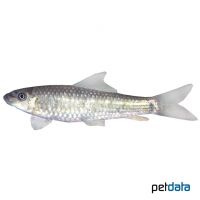Mullya Garra (Garra mullya)
| Mullya Garra Garra mullya | |
|---|---|
| Name | Mullya Garra |
| Name Lat. | Garra mullya |
| Family | Carps |
| Family lat. | Cyprinidae |
| Order | Carps |
| Order lat. | Cypriniformes |
| Origin | Asia |
| Habitat | Streams, rivers |
| Diet | Omnivore |
| pH | 6.0-7.5 |
| Behavior | Peaceful |
| Keeping | Group |
| Care Level | Moderate |
| Reproduction | Egg scatterer |
| Breeding | None reported |
| Life Span | 2-4 years |
| Protection | No |
| Metric Units | |
| Size | 12-17 cm |
| Temperature | 20-26 °C |
| Hardness | 5-15 °dH |
| Aquarium | 240 l |
| US Units | |
| Size | 4.7"-6.7" |
| Temperature | 68-79 °F |
| Hardness | 89-267 ppm |
| Aquarium | 65 gal |
Distribution and habitat
Indian algae eaters are widespread in river systems on the Indian subcontinent. They live in various biotopes, such as mountain streams and lowland rivers with rocks, boulders and open sandy areas.
Maintenance
The aquarium should be structured with stone structures (caves), boulders and roots as well as free sand areas and have dense planting in places. A substrate of sand or fine gravel, oxygen-rich water and some current is ideal.
No ammonia, ammonium and nitrite should be detectable, the nitrate value should not exceed 100 mg/l. To ensure the water quality and oxygen content, a filter and heater adapted to the aquarium size is required, as well as lighting for the species-appropriate day-night rhythm of the animals.
Diet
They feed mainly on the vegetable cover (growth) of stones, wood, plants, etc. and the microorganisms found in them. For a balanced diet, feed them once a day with a high-quality sinking dry food (granules, tablets) as well as cyclops, daphnia or mosquito larvae (live or frozen). In addition, they need vegetable food, such as crushed peas, scalded spinach, zucchini slices or algae leaves.
Only feed as much as will be eaten within a few minutes. A regular and varied diet promotes health and increases resistance.
Behaviour and compatibility
They are sociable and relatively peaceful fish, which should be kept in a group of 3-4 animals, but better more. Socialization with other peaceful fish, such as Danio, Devario, Puntius or loaches is very possible. Animals kept singly often become aggressive.
Basically, only compatible fish species with similar demands on water condition and water temperature should be socialized.
Sex dimorphism
Adult males are more slender than females and develop distinct tubercles on the head.
Reproduction and breeding
There are no known reports of successful breeding in the aquarium.
Important
Strong lighting promotes the growth of algae, which serve as food for them. They also feed on diatoms.
The aquarium should be well covered, because the Indian algae eaters like to jump.
The well-being of the fish should be checked regularly. Temperature should be checked daily, pH, hardness and nitrate levels at least every 14 days. Regular partial water changes are recommended, even if the contaminant level has not yet reached the upper limit. Sudden changes in water quality should be avoided. Newly introduced fish must be accustomed slowly to the water in the aquarium.
Further literature can be found in your pet store.
References
Text: Werner Winter; Image: petdata
Source: BMELV (1998): Tierschutzgutachten - Haltung von Zierfischen (Süßwasser); BAENSCH & RIEHL (2004): Aquarien Atlas Bd. 2, Mergus Verlag; ENGELMANN (2005): Zootierhaltung - Tiere in menschlicher Obhut: Fische, Verlag Harri Deutsch
- Gemäß § 21 Abs. 5 Tierschutzgesetz idgF
